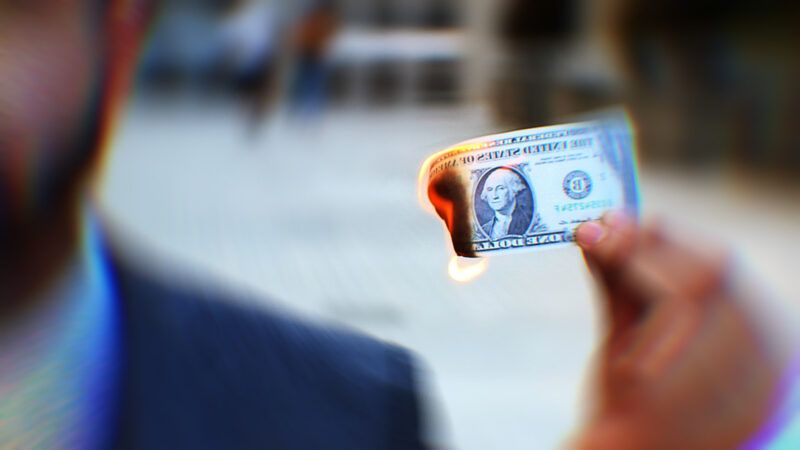Government Pandemic Loans Plagued by Potential $260 Billion in Fraud
The hasty work behind the PPP and other relief loans shows the limits of big government.

All told, Congress has authorized about $5.9 trillion in spending to address the social and economic fallout from the pandemic, of which $4.32 trillion has been disbursed or committed already. By now, more than a year into this unprecedented burst of spending, there's sufficient hindsight to assess the federal pandemic response, and the early results bode poorly for proponents of "big government."
In a new Cato Institute Legal Policy Bulletin, I describe the Small Business Administration's (SBA) shambolic implementation of two marquee pandemic policies. The first is the $813 billion Paycheck Protection Program (PPP), involving federal loan guarantees, set at a low interest rate (1 percent), which could be forgiven if the borrower spent a certain percentage (about two-thirds) on payroll. The second is the $367 billion Economic Injury Disaster Loan (EIDL) program, which entails loans on favorable terms that are disbursed directly by the government.
Both of those pandemic programs reflect gross expansions of troubled frameworks. The PPP is an extension of the SBA's "section 7(a)" loan guarantee program, which, in the years prior to the pandemic, was an annual presence on the Office of Management and Budget's list of "high priority" programs that warrant greater scrutiny due to their poor stewardship of taxpayer dollars.
Similarly, watchdogs had sounded alarms about core aspects of the EIDL program (including the SBA's assessment of creditworthiness and applicant eligibility) long before COVID-19 plagued us. Despite these repeated warnings, the EIDL program reported its highest-ever improper payment rate of 11.98 percent in the fiscal year before the pandemic, among the worst rates in government.
From this suboptimal baseline, both programs were further stressed by a vastly increased workload. For example, in a "normal" year, the SBA makes about 62,000 loan guarantees, totaling $16.7 billion, under the section 7(a) program; over the first year of the PPP, in comparison, the agency made more than 9 million loan guarantees worth $746 billion. The EIDL program, too, exploded: In the first year of the pandemic, the SBA disbursed about twice as many direct loans as the agency had made over its entire 67-year history before COVID-19.
Overwhelmed, the SBA cut corners to facilitate the flow of public funds out the door. For the PPP, the agency relaxed underwriting controls for lenders, waiving basic documentation requirements like financial statements and income tax returns. The Government Accountability Office faulted this decision, among others, in a report whose blunt title speaks volumes: "COVID-19 Loans Lack Controls and Are Susceptible to Fraud."
Regarding the pandemic EIDL program, the inspector general determined that the SBA "lowered the guardrails," which "significantly increase[ed] the risk of fraud." His office also reported that the SBA for months "ignored" a subcontractor's system for flagging suspicious loans.
To recap, these already troubled programs loosened their existing safeguards to process their unprecedented workload. This is a recipe for disaster and, predictably, the results have been dire.
About halfway through the PPP program, the inspector general warned of "widespread fraudulent activity." By the end of September 2020, his office had received more than 77,000 hotline complaints of potential fraud, and since then, "the numbers continue to rise." In addition to the risks posed by scammers, there is the related risk posed by administrative inefficiency at the SBA. In December 2020, an independent financial statement auditor flagged as potentially improper payments more than 2 million approved PPP loan guarantees, with an approximate value of $189 billion.
Turning to the EIDL, the inspector general has warned of "rampant fraud," and a preliminary assessment conducted by his office flagged more than $77 billion in approved loans that evinced "strong fraud indicators"—or almost 46 percent of the EIDL applications that had been approved up through last October ($169 billion). Of course, the SBA has continued to make loans since then, and accordingly, the inspector general cautioned that "the potential fraud in the COVID-19 EIDL Program has continued to grow."
For both programs (EIDL and PPP), the SBA's response to criticism has been illustrative. Over the past year, various public and private watchdogs have issued a raft of reports that are all in agreement that the SBA's management failures have placed huge sums of taxpayer money at risk. In response, the agency effectively buried its head in the sand. Last October, for example, the inspector general observed that "SBA's management continues to insist that its controls are robust despite overwhelming evidence to the contrary."
In sum, more than $260 billion (and counting) in taxpayer money has been placed at undue risk by administrative bungling at the SBA. To be sure, the federal government faced an extraordinary challenge. Due to the very nature of Congress's intention to quickly aid those affected by the pandemic and its economic effects, federal relief programs were at an increased risk of improper payments. Still, while it may be that some level of waste is acceptable in an emergency, the SBA's miserable performance is beyond the pale, and serves as a stark reminder of the limitations of "big government."



Show Comments (56)